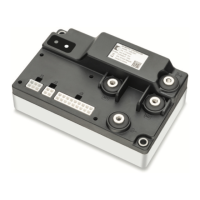3 — PROGRAMMABLE PARAMETERS
Curtis Model 1226 – September 2019
Return to TOC
pg. 34
Table 25 Throttle Types and Driving Direction
Throttle Type Description
Dual switch The controller uses forward and reverse switches to determine the driving direction.
Note: If both switches are active, the controller considers it an error and clears the
throttle command.
Single switch The controller uses the status of the reverse switch to determine the driving direction.
If the reverse switch is inactive, the controller drives the motor forward. Otherwise the
controller drives the motor in reverse.
Wigwag The driving direction is based on the throttle input:
• If the throttle input is between the values of the Forward Max and Forward
Deadband parameters, the controller drives the motor forward.
• If the throttle input is between the values of the Reverse Max and Reverse
Deadband parameters, the controller drives the motor in reverse.
• If the throttle input is between the values of the Forward Deadband and Reverse
Deadband parameters, the controller considers the vehicle to be in neutral.
THROTTLE MENU, cont’d
PARAMETER VALUES DEFAULT DESCRIPTION
HPD/SRO Type [PCF] 0-2 1 Indicates whether the HPD/SRO function is enabled.
If HPD/SRO is enabled, the controller generates the HPD/
Sequencing fault when it detects an HPD condition. Whether the
controller generates the fault for SRO conditions depends upon
the parameter value and the throttle type specied with the
Direction Source parameter:
0 = Disabled.
1 = HPD/SRO enabled for material handling vehicles. For dual
switch throttles, the controller detects SRO if the forward
or reverse direction is selected before the interlock input is
turned on, and ignores SRO for the other throttle types.
2 = HPD/SRO forward only. For single switch and dual switch
throttles, the controller detects SRO if the forward direction
is selected when the interlock input is turned on, and
ignores SRO for wigwag throttles.
Note: For single switch throttles, the forward direction is selected
when the reverse switch is inactive.
See Understanding the HPD/SRO Function on page 36.
Sequencing Delay 0.1-5.0s 0.5s Sets the time during which the interlock cycles before an HPD/
Sequencing Fault occurs.
A delay is useful for cases where the interlock might be momentarily
cycled, such as when an operator briey bounces off the seat. In
such cases, the vehicle typically should continue moving.
Speed Limit Pot [PCF] On/Off Off Species whether the vehicle uses a speed limit pot.
On = Uses a speed limit pot
Off = No speed limit pot

